REEL RETRO CINEMA returns with a monkey on its back.

I don’t think I’ve ever written about this but I loved the 1976 version of King Kong. And heretical it may be, it’s still probably my favorite, though I know that’s the nostalgia talking.
Either way, with Kong: Skull Island out this week, it’s the perfect time to revisit the first American Kong remake blockbuster, so here’s Rob Kelly with his latest REEL RETRO CINEMA, in which he gives new looks to old flicks and their comic-book adaptations. (By the way, I also had that King Kong treasury he writes about. I read that thing over and over. It was my stand-in for the movie in those pre-home video days.)
Also, make sure you check out Rob’s Film and Water Podcast episode on King Kong ’76 (click here) and his Treasurycast episode on the Kong treasury edition (click here). You’ll be glad you did. — Dan
—
By ROB KELLY
“Nobody care when Jaws die. Nobody cry when Jaws die. When my Kong dies, everybody cries.”—Producer Dino De Laurentiis
Since we are about to take another trip to Skull Island in Kong: Skull Island, we here at REEL RETRO CINEMA thought it would be worth a look back at a previous cinematic adventure of the Eighth Wonder of the World. Not the 1933 original—one of the great achievements in all of cinema—nor Peter Jackson’s mega-budget 2005 remake. No, we’re here to look the often-maligned 1976 King Kong, starring Jeff Bridges, Jessica Lange and Charles Grodin, produced by legendary Hollywood showman Dino De Laurentiis.
After a protracted battle between studios to obtain the rights from the long-dead RKO Pictures, De Laurentiis promised the world a new King Kong for the 1970s, on a scale that had literally never been attempted before. Before a single frame of film was shot, De Laurentiis commissioned a poster by fantasy artist John Berkey, who almost did his job too well. Who could not want to see a movie, based on this?

I had an unlettered version of this poster on my wall as a kid. Then again, so did most boys in the ’70s. — Dan
One of De Laurentiis’ original ideas for the film was to create nothing less than a 40 foot-high animatronic King Kong, along with some fake buildings built to scale. It didn’t take long before the effects team informed De Laurentiis that this notion was essentially impossible, so the production (helmed by director John Guillermin, who had just come off The Towering Inferno) went ahead with less grandiose ways of bringing Kong to life—namely, a full-size Kong head, some giant ape hands for close-up shots, plus a series of highly-detailed costumes to be worn by actors and shot, Godzilla-style, amid miniature sets.
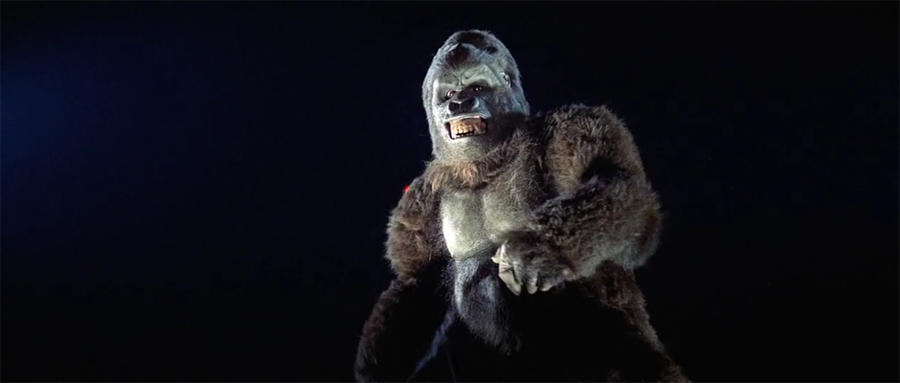
The basic plot of King Kong ’76 differs the most from the original in its first third. Instead of movie producer Carl Denham venturing to a remote island to make a grand adventure epic, we have oil company big wig Fred Wilson (Charles Grodin, whose mustache here deserves its own SAG card) leading an expedition to find a big deposit of oil. Along for the trip are two henchmen played by Rene Auberjonois (Odo from Star Trek: Deep Space Nine) and Jack O’Halloran (Non from Superman II), as well as a stowaway named Jack Prescott, a primatologist played by the Dude himself, Jeff Bridges.
Along the way, Prescott tries to talk Wilson out of his plan of environmental exploitation, but Wilson is having none of it. Prescott finds himself distracted when the crew discovers a beautiful young woman (Jessica Lange, in her film debut) floating all alone on a life raft. After being rescued, the young woman named Dwan (“It’s more memorable that way”) explains she was on a yacht with a bunch of rich fat cats when it sank—the guys were all too busy down below watching a porno. Jack and Dwan take an instant like to one another, even though Bridges is sporting one of the most hideous beards in all of movie history.
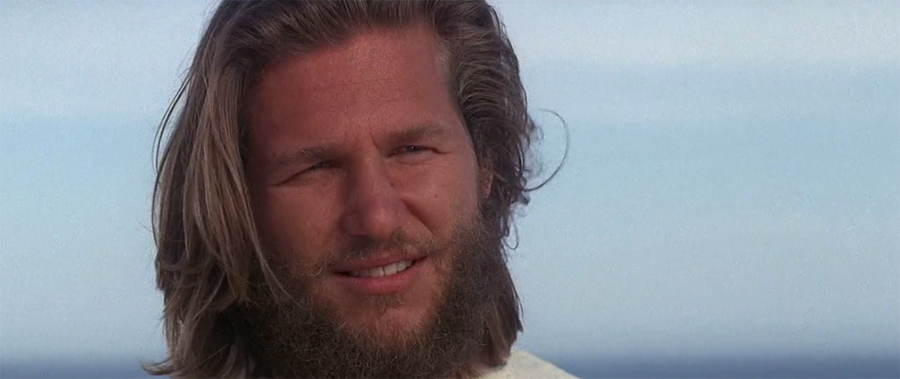
Wilson discovers to his horror that the oil lode isn’t quite what he hoped—it still needs several thousand years of sitting in the ground before it will ever be ready to be extracted. But he refuses to have come all this way for nothing, so when they discover a giant, 40-foot-high ape living on the island, he decides to change plans and bring this “King Kong” back with him to America—after all, what a marketing gimmick it will make!
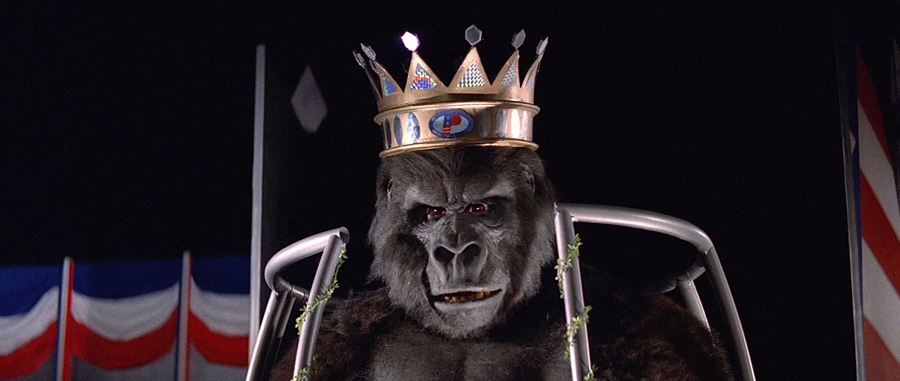
Wilson and his team subdue Kong and ship him back to the States, and it goes about as well as it did for Carl Denham. Kong is trussed up—with a giant clownish crown atop his head, to boot—and presented as Petrox Oil’s new mascot. When Kong sees Dwan—whom he fell for, hard, back on Skull Island—seemingly in trouble, he flips his lid and runs amok. As the poster suggested, instead of the Empire State Building, this Kong scales the newly built World Trade Center, where a climactic battle is fought against a squad of heavily armed helicopters. Once again, the mighty King Kong ends up the loser.
I didn’t see King Kong ’76 in the theater—I was just a shade too young—but the movie’s imagery always loomed large in my imagination. De Laurentiis arranged for licensing deals aplenty, and there were dozens upon dozens of products (how about a Mego King Kong drink straw where you watch him scale the Twin Towers? No?), most of them featuring that amazing poster.
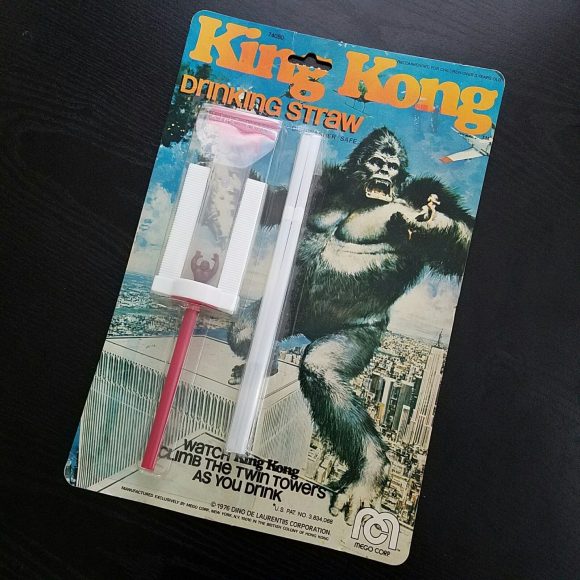
Bidding starts at $300 over on eBay.
Sure, Star Wars, released just a year later, would really change the face of movie merchandising, but King Kong was no slouch in that department—there were toys, models, View-Master reels, lunch boxes and a board game that I have many fond memories of playing. All this kid-friendly marketing is retroactively curious when you consider how much grim stuff goes on in this movie!
Written by the Batman TV show’s Lorenzo Semple, Jr., King Kong ’76 does have its share of “camp” humor moments. At one point Dwan, in the grips of a smitten Kong, asks if he is a “chauvinist pig ape.” Grodin, as our main bad guy Wilson, is barely more subtle than what you saw from the bad guys on Batman—he’s so comically evil that he’s hard to take seriously. Jeff Bridges’ hippy-dippy Jack “That’s just, like, your opinion man” Prescott seems to be our leading man, but then at times is so blandly ineffectual that we find ourselves turning to the guy in the ape suit for someone to root for.
But in keeping with tradition when it came to a lot of ’70s cinema supposedly aimed at kids, King Kong ’76 has a lot of stuff in it—some subtextual, some right out in the open—that from a modern perspective seems pretty adult. The scenes with Kong and Dwan are almost absurdly sexual—after getting coated in mud, Kong runs Dwan under a waterfall, leaving her sopping wet. He then makes like Superman and blow-dries her, and Dwan’s response is to look…well, pretty turned on.
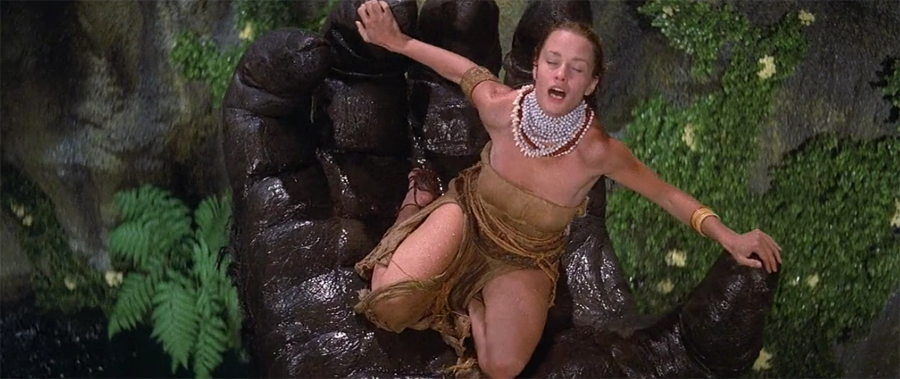
She has a similar reaction when King Kong ’76 recreates a scene from the original that’s cut often by censors, where Kong runs his finger along the beautiful blonde’s body, poking at her occasionally. In 1933, the scene was considered offensive, but Fay Wray (IMO) played the scene more as scared than anything else. Here, again, Dwan looks like she’s genuinely enjoying the attention, if not the actual physical sensation of being stroked in her nether regions by a giant hairy, phallic object. Sure, the Beauty and the Beast thing has always been inherent to the King Kong story, but IDK seems kinda weird to me to have an extended pro-bestiality scene in a movie that came with a tie-in for fast-food drinking glasses.

But, hey, it was a different time.
And it’s not just the sex in King Kong ’76, it’s the violence too. When the Army helicopters start peppering away at Kong atop the WTC, blood spurts from the poor beast. Throughout most of the film, Kong was played by F/X legend Rick Baker. Since liquid can’t be done in miniature, we have repeated scenes of rivulets of red bursting forth, filling the screen in a way the filmmakers probably didn’t intend. By the time Kong falls from the second tower, he’s covered in blood, an extremely gory sequence for a movie that was rated PG.
While it’s probably impossible ever to find out whether De Laurentiis or Semple meant this, King Kong ’76 features a healthy dose of social commentary. The 1973 oil crisis was still fresh, and here we have an American oil company leaving its big, imperialist footprint on pristine native lands, consequences (or nature) be damned. On a similar track, Dwan is no angel—as played by the supremely talented and whip-smart Lange, she initially seems like a harmless ditz — until she gets a taste of celebrity, thanks to her being the apple of Kong’s eye.
She goes along with being used as a prop by Petrox, down to recreating her first encounter with Kong, this time in a parking lot crammed with bleachers full of yahooing Ugly Americans. They cheer at watching this noble beast reduced to being a goddamn corporate mascot, so when it all goes wrong, you have to think King Kong ’76 has a little more on its mind than the escapist fare De Laurentiis was promising.
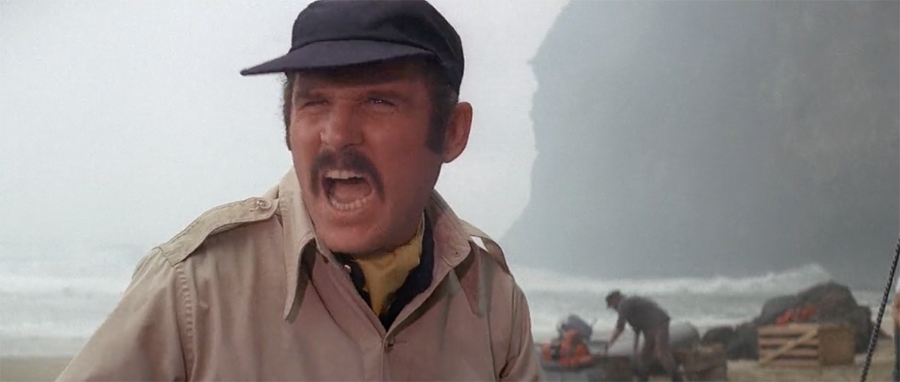
I don’t mean to make it sound like King Kong ’76 is some hidden-in-plain-sight subversive classic. It’s not. The effects during the third act—when they should be at their best—are dodgy. After Kong escapes and is presumably running amok in New York City, hardly anyone outside of our main characters seem to notice (I know it was the 70s, but things weren’t that loose). Too often it’s clear that King Kong is just a guy in a suit stomping around fake buildings and action figure-sized people. The effect is comical, not mysterious and awe-inspiring, something you still get from the 1933 original. As I mentioned, Grodin is too silly to be an effective bad guy, and Prescott tries a pick-up line on Dwan (“The ape had the right idea”) that is so awful even the natural, effortless charm of Jeff Bridges can’t sell it.
But King Kong ’76, by placing the story in contemporary times, manages to find something new to say using the same basic story, something I don’t think the massively talented Peter Jackson was even quite able to pull off in 2005. It tells a bleak tale about how human nature probably won’t ever learn, whether it’s the 1930s, or the 1970s. We’ll soon see what, if any, message Kong: Skull Island has for us in the 21st Century.
Amid all the King Kong merchandise cranked out at the time, there is one item that we should spend a minute or two talking about before we wrap up. Namely, the treasury-sized King Kong movie adaptation published that same year by the fine (if bland) folks at Whitman. Although when I call it a movie adaptation, that’s a bit of a mislead—it is an adaptation, but of the 1933 original!
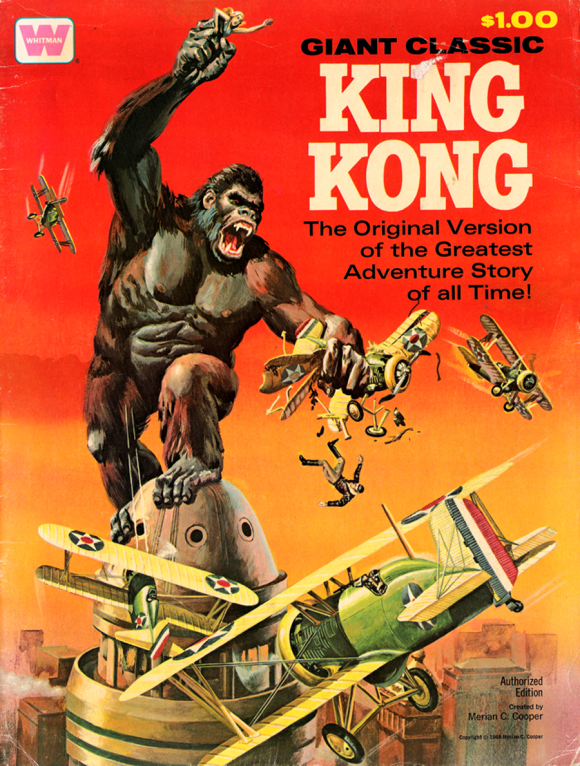
Published in 1968 by Gold Key (aka Western) as a regular-sized comic, King Kong features a spiffy painted cover George Wilson. The adaptation was drawn by Giovanni Ticci and Alberto Giolitti and is a straightforward—if a little passionless—four-color version of the movie. It faithfully hits all the story beats, but with all the edges sanded down so this King Kong is palatable for even the youngest readers.
The first shot we get of Kong is a close-up, undercutting what should have been a dramatic reveal of the giant ape. Colored Superman-hair blue, Kong—who always seems to be staring off into the middle distance–never really looks very menacing. Instead, he has almost a Grape Ape kind of thing going.
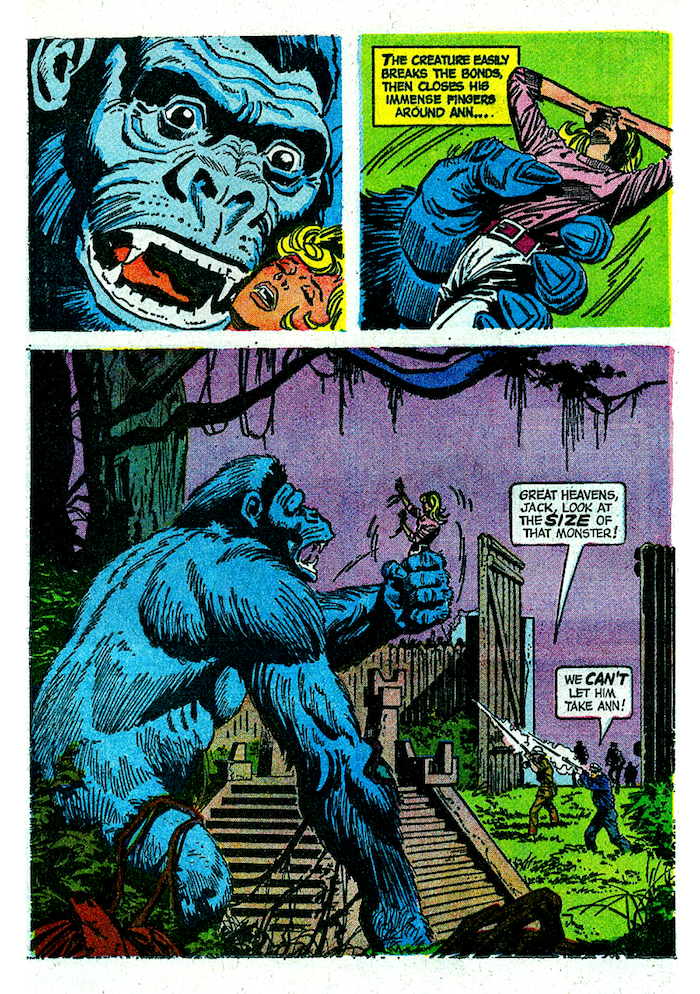
Like a lot of movie adaptations Gold Key cranked out in the 1960s, when tastes were changing but their comics were not, the comic is OK. But not anything more than that. In the massive merchandising wave King Kong ’76 stirred up, the publisher took the book and simply republished it, this time at Kong Scale—i.e., as a treasury edition! Other than the larger size, however, the book is exactly the same, giving no indication it has any connection to the remake.
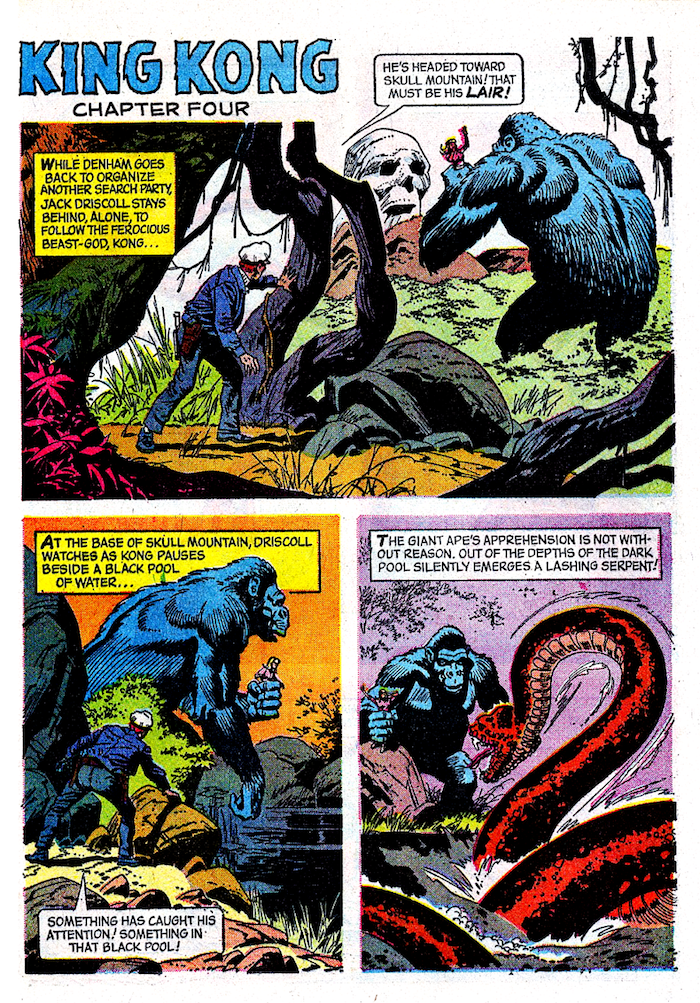
It’s a real shame that De Laurentiis, who never left a merchandising stone unturned (did I mention the King Kong drinking straw?), didn’t think to tap Marvel or DC—both of whom had a lot of experience with ape comics—to do an all-original comic-book version of the movie. If the Big Two could team up do adapt The Wizard of Oz, why not King Kong? And, come to think of it, why isn’t there a treasury edition of Kong: Skull Island available? Another missed opportunity! Oh well.
If Kong: Skull Island is the hit it looks to be, plans are supposedly afoot to pit KK against the Godzilla in a modern-day big screen battle royale. As we all know, the treasuries are great for when two titans square off, so let’s start bugging DC and Marvel now to get working.
Who’s with me?
—
If you want to hear more about the 1976 King Kong treasury, check out Treasurycast, part of The Fire and Water Podcast Network!
And if you want to hear more about King Kong ‘76, check out the new episode of The Film and Water Podcast, part of The Fire and Water Podcast Network!
—
Rob Kelly is a writer/artist/comics and film historian. He is the co-host of Aquaman and Firestorm: The Fire and Water Podcast, the host of The Film and Water Podcast, and the host of TreasuryCast, a show devoted to the greatest comics format of all time, the treasury edition. He’s working on growing a Charles Grodin mustache.

March 8, 2017
This movie, Jaws, and The Thing are three of my most treasured memories from the 70’s. My lord, was Jessica Lange a beauty!
August 2, 2017
The Thing was 1982. Just sayn…
March 8, 2017
I went to see this with two older cousins. I was five. During the climactic final scenes when King Kong knocked down one of the helicopters I stood up in the theater and shouted “I’m proud of you KING KONG!!!!!” Needless to say my cousins never took me to another movie. The straw, the glasses from BK, that comic book, the view master version, and a stuffed animal Kong. I had all of those things as a child. Thanks for this story. I had forgotten what a huge deal this movie was to my childhood.
July 14, 2022
Fun look back. It should be noted though that De Laurentiis did have a giant life size Kong animatronic made. It appears in a couple of blink and you miss it spots in the film. The legs which don’t move at all, are pretty good give aways. If you see a shot where Kong looks like a stuffed doll, that’s the animatronic.
I’ve never understood why they didn’t use it for a couple of perspective shots, TBH, as that’s where it might have looked good.
December 22, 2023
The 1976 film might be rated PG-13 if resubmitted to the MPAA today due to what is mentioned above. Particularly the bloody fight scene. The 1933 film would likely be rated PG if resubmitted to the MPAA today.
March 2, 2023
The name of the oil company…. “Petrox”…really?? Pet Rocks?